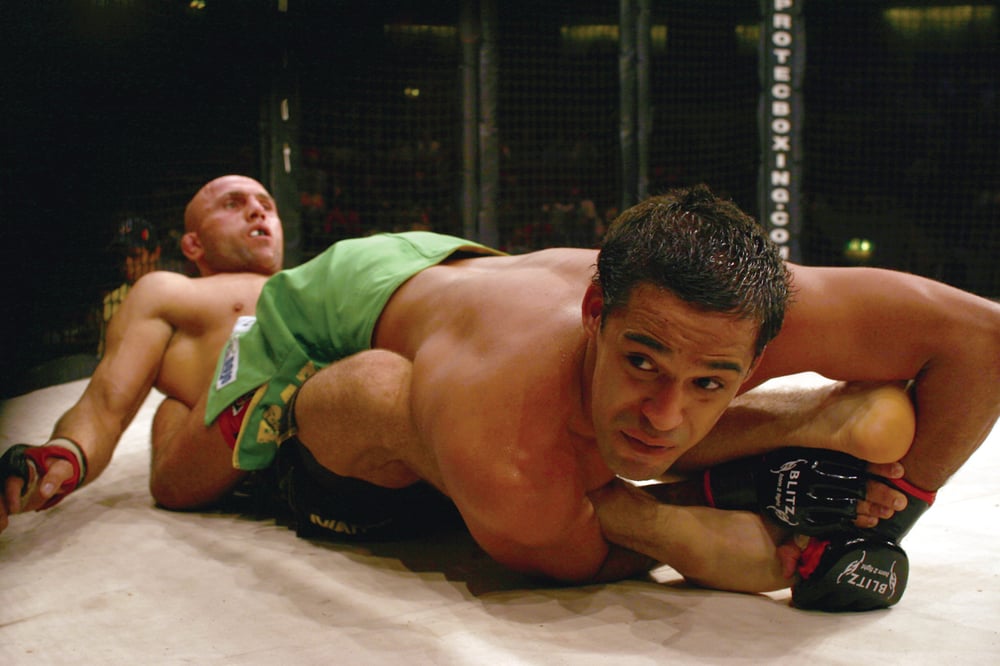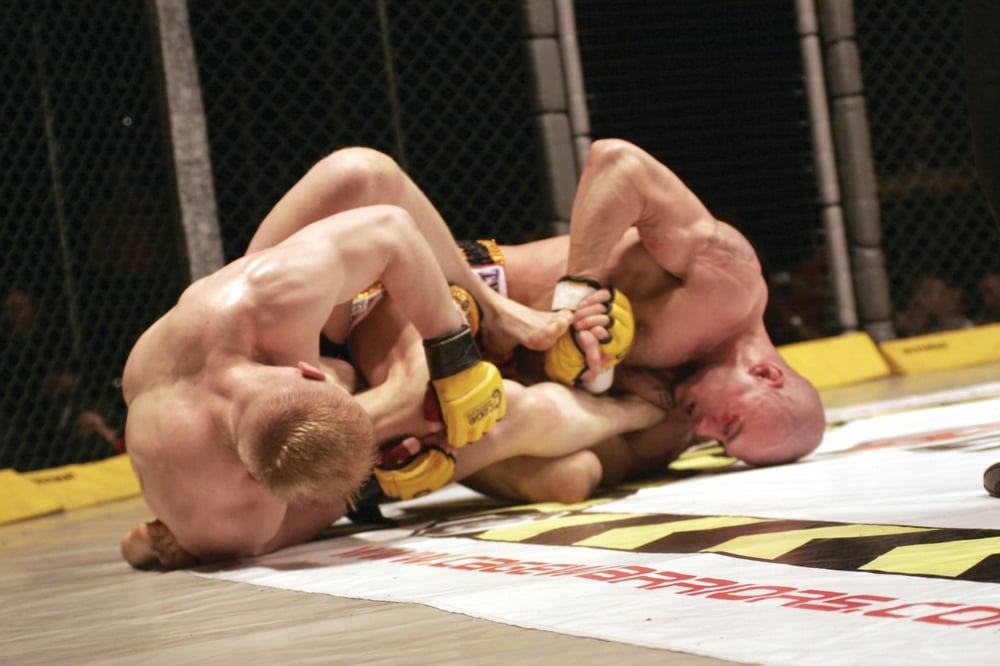
Issue 025
May 2007
Anatomy of a submission
By Rosi Sexton
The ankle is the last major joint that we have to cover in this series. There are two types of ankle lock that we need to consider: the Achilles lock and the toehold. First, some anatomy. As with most of the areas we’ve looked at, the ankle is not a simple joint between two bones.
Anatomy of the lower leg
The joint responsible for most of the movement at the ankle is the talo-crurual joint. This is where the long bones of the leg – the large tibia (or shin bone) and the much smaller fibula form an arch. The ends of this arch are the knobbly bits on the sides of the ankle, and between these is wedged the talus, one of the tarsal bones of the ankle. It is the hinge-like movement of this joint which gives us the major movements at the ankle. In most of the other joints we have discussed, we have talked about the movements of flexion and extension. The ankle is different. For reasons that we don’t need to go into, the main movements at the ankle are known as plantarflexion (pointing your foot, such as when you stand on tiptoe) and dorsiflexion (pulling your foot up towards you).
The talo-crural joint is not a pure hinge joint, and does allow some other movements. There are also other important joints within the ankle complex that give the flexibility of movement we normally experience. The talus itself sits on top of the calcaneus (heel bone). The joint between the talus and calcaneus allows inversion (turning the foot inwards, such as when you stand on the outside edge of your foot) and eversion (turning the foot outwards). This movement also occurs between the other carpal bones, giving the foot the flexibility needed for smooth walking.
There are many, many ligaments in the foot and ankle. The most relevant to us are the ligaments on the lateral (outer edge) and medial (inner edge) sides of the talo-crural joint. On the medial side is the four-part deltoid ligament. This is very strong and rarely injured. In contrast, most ankle sprains damage the ligaments on the lateral side of the ankle. There are three key ligaments here – the anterior and posterior talo-fibular ligaments and the calcaneo-fibular ligament. These are stressed when the foot is twisted inwards, such as when someone “goes over on” their ankle.

The Toehold
In a toehold, the foot is twisted inwards and forwards (inversion and plantarflexion) and rotated towards the midline. The first two components of this movement stress the ankle joint itself; the rotational component acts mostly on the knee in much the same way as a heel hook (discussed last issue).
The ligaments on the outside of the ankle are under the greatest stress, especially the anterior talo-fibular ligament. A reverse toe-hold is also possible, twisting the ankle in the opposite direction, but is harder to cause damage with (or get a tap), because of the greater strength of the deltoid ligament on the medial side.
In addition to ankle damage, the toehold can also damage the knee in the same way as a heel hook by using the foot as a lever to twist the lower leg. With a standard toehold, the weaker ankle ligaments are more often damaged first, but with a reverse toehold damage to the medial and lateral collateral ligaments of the knee is more likely.
It rarely happens that an ankle may be fractured with an explosively applied toehold, if the emphasis of the lock is placed on rotation and the foot is relatively dorsiflexed, jamming the talus in the archway formed by the tibia and fibula. The fibula is the most commonly fractured bone in this situation.

The Achilles
An Achilles (or straight ankle lock) works on a different principle. It has two different actions, depending on exactly how it is applied and on the flexibility of the person it is being applied to.
A great deal of the pain of the lock is caused by the forearm compressing the Achilles tendon and the soft tissues around it. The Achilles tendon runs from the calf muscles gastrocnemius and soleus to the calcaneus (heel bone), and it is by pulling on this tendon that the calf muscles plantarflex the foot. Compressing this tendon can cause a lot of pain and bruising.
The other effect of an Achilles lock is to hyperextend (strictly speaking to hyper-plantarflex) the talo-crural joint. Once again, this can cause ligament damage, probably to the lateral ligaments, possibly to some of the other ligaments between the carpal bones, and potentially to the joint capsule and joint itself.
Post Injury Treatment and Care
As always, injuries are best dealt with in consultation with a trained professional with experience in sporting injuries, such as a physiotherapist or osteopath. Rest, Ice, Compression and Elevation should be applied as soon as possible after the injury, and used for at least three to five days. Severe injuries should be seen by an accident and emergency department to check for fractures.
Ankle injuries often heal reasonably well (in comparison to the knee joint), but also tend to reoccur. Once a ligament has been damaged, a person may find that he will injure it repeatedly in the future. This is why good rehabilitation is essential. It is especially useful to work on balance (proprioception) at the ankle joint. The body has a sense of where the joints are in space, and this helps you to automatically correct or prevent movements that are likely to cause injury – such as when you start to go over on your ankle. This ability is impaired when the ankle is injured, and by retraining this ability it makes it less likely that you will suffer from repeated ankle injuries in the future.










